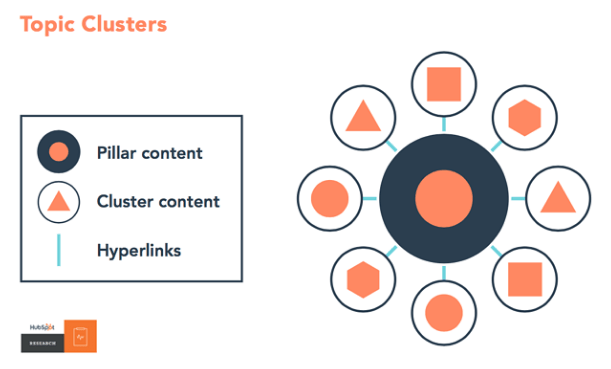Because of the constant evolution of search engine algorithms, one of the most important things you will need to do to improve your SEO strategy and enable your content to rank higher in search engine results, is to create pillar pages and topic clusters.
What Is A Pillar Page and Topic Cluster Content Strategy?
A pillar page is a single webpage (or blog post) that provides a comprehensive overview and resource of the main topic of your business, product, or services. While topic clusters, which are all linked back to a pillar page, are groups of interconnected sub-topic blog posts, webpages and articles that are structured around the primary topic.

An effective pillar page and topic cluster strategy can help organise your website, provide value to readers, and drive traffic to your content from the search engines. It can also help you to establish yourself as an authority in your niche, decrease bounce rates, and increase the time visitors engage on your site.
If you’re just starting to build your webpages and content, and you want to know what the best practices are, and the most common mistakes to avoid, then you’ve come to the right place. In this article, you will learn the do’s and don’ts of creating a pillar page and topic cluster content strategy, so you can start improving your conversion rates.
The Do’s and Don’ts of Creating Pillar Pages and Topic Clusters
1. Do Perform Proper Keyword Research On Your Primary Topic
One of the most important steps you need to take before you start building your a content strategy for your website is to perform proper keyword research for your core topic. This should be specific to your industry, and naturally supports your business, products, or services.
The keywords you use in your website content are vital because they make it possible for people to find your website through search engine platforms like Google. If you can organise your pillars and clusters to match the keywords your customers are searching for (along with search intent), then Google will consider your site as an authority on a particular niche, and rank you higher in its search results.
To perform keyword research, you first need to decide what your primary topic is, and then use a keyword research tool to analyse and identify several related keyword topics that you could write content for. With such tools, like Google Rank Tracker, you can get all the information you need to discover the best paths to take when it comes to topic clusters.
Once you have figured out which keywords you’re going to use, the next thing you can do is to incorporate those words and phrases into your pillar and cluster content pieces, titles, subheadings, and anchor texts. Then, link them all together.
2. Do Create Proper Outline for Your Pillar Pages and Topic Clusters
After performing keyword research, the next thing you want to do is to outline the structure of your pillar page and topic cluster strategy. The best way to do this is to consider your pillar page first, as all of your topic clusters will link back to it.
The outline for your pillar page should include everything it needs to cover a broad range of related topics. On the other hand, the topic clusters should cover all sub-topics of the main topic. When determining clusters, you should make sure that the sub-topics you develop are relevant, so they can link back to the pillar page.
3. Don’t Stuff Your Content With Too Many Keywords
When it comes to keywords, however, there are several things you also need to consider when adding them to your website content. One of the most common mistakes content writers and marketers make is “keyword stuffing,” which means loading your content with unnecessarily repeated words and phrases that are irrelevant and out of context in relation to the primary topic.
If you do this, Google will recognise it as an attempt to manipulate search engine rankings, and it will rank your site lower in the search results. The best thing you can to avoid accidentally keyword stuffing your content is to focus on writing for your specific audience using their language, build a keyword list, make it a habit to review your content, and incorporate long-tail keywords.
4. Do Incorporate Links
After producing your content pieces and incorporating keywords into them, the next thing you want to do is to add links. You have to create internal and external links throughout the context of your primary topic and sub-topics, and take advantage of them to support statistics, lead to other articles on your site, and other credible third-party sources. This will help to build up your authority.
5. Do Use Calls-to-Action (CTAs)
Apart from producing high-quality content, using relevant keywords and utilising links, another thing you should do to improve the performance of your website and increase your user engagement is to make use of call-to-actions. These lines of texts (or images) are designed to compel your site visitors to take your desired action, such as download a piece of premium content or make an enquiry.
6. Don’t Confuse Your Readers
When it comes to using calls-to-action, however, you should avoid being too wordy, using different wording in your CTAs and landing pages, or using vague or passive language. Whether it’s telling them to “Get their free trial,” Learn more” about a product, or “Buy now,” be straightforward with your CTAs.
Additionally, when creating CTAs, you should make sure you A/B test them to see which ones actually work and convert.
How A Pillar Content Strategy Helps Your Online Business
As mentioned above, there are many benefits to building a pillar page and topic cluster strategy for your online business.
When it comes to pillar pages, having comprehensive content allows your audience to gain a good understanding of your business idea, topic, products, or services. They are usually longer than blog posts, they give links to other content, and they contain a hyperlinked table of contents at the top of a page.
When it comes to topic clusters, on the other hand, they have the ability to make your content more visible. Each of your topic clusters can allow you to explore specific topics more in-depth, and therefore, they can be considered to be like the branches that branch out of your pillar page.
In conclusion, pillars and clusters can increase your website’s search engine visibility and establish yourself as an authority in the eyes of Google and other search engines. They can also help minimise your website’s exit rates, improve user experience and increase website traffic, user engagement, and conversion rates.
Final Words
There you have it! Pillar pages and topic clusters have real benefits for your website and online business. If you want to succeed in building them for your wepages, then you will need to perform proper keyword research for your core topic, create an outline for main and secondary topics, create high-quality content that links back to the pillar page, incorporate other internal links, and make use of call-to-actions.




